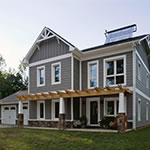When walking through the Specht Home in Thaxton, Virginia, one of the first things one notices is its airy feel. The bright colors on the walls and ample lighting from the windows and glass doors fill the house with an openness that seems to defy the tight seals that make it Passive House certified.
The Specht Home won the Greenbuilder 2013 Home of the Year award and yet was constructed for just $150 per square foot by Adam Cohen at Roanoke-based Structures Design-Build (read our Q&A with Cohen), proving that Passive House is not out of reach for American homeowners. In fact, Cohen had to convince Jason and Stephanie Specht that the cost to build to Passive House standards would not be prohibitive.
A major reason it can be expensive to build Passive House-certified buildings is that many materials have to be shipped from Europe, where the standard matured and so is better understood. Klearwall Industries, which supplies windows and doors from Irish company Munster Joinery, came to the United States to change that. “The idea behind Klearwall was to supply the US market with the most energy-efficient products possible,” says Klearwall CEO Brendan Harte. “The best place to do that was through Munster Joinery.”

Munster’s PassiV window range won the 2013 Green Product Award from the Green Awards, which recognizes sustainable products and practices among Irish companies, organizations, and individuals. Munster offers five lines of Passive House-certified windows, all of which have been brought to the US market by Klearwall, including two tilt-and-turn and three casement models. Each comes in a variety of colors and is constructed with thermal performance in mind.
Whereas most Passive House materials that are shipped from overseas can take months to arrive—dramatically slowing production schedules—Klearwall’s shipping time is comparable to US-based suppliers: about six to eight weeks. And the company offers on-site assistance and installation. “There are a couple of other suppliers of European windows in the US, but people find that they get very little support from the companies,” Harte says. “And many things are in metric rather than imperial. We convert for our customers and offer them the assistance to understand what our doors and windows can do.”
Klearwall’s commitment to sustainable products and practices goes beyond its doors and windows. “You should practice what you preach,” Harte says, and the idea that a company selling a green product should practice green operations has been part of Klearwall’s identity since its inception. At Munster, renewable resources are used in the manufacturing facility. Two wind turbines supply 30 percent of Munster’s total energy requirements, and 77 percent of the electricity generated is used on-site.
The importance of sustainable operations, commitment to customer ease and satisfaction, and an extensive line of products all set Klearwall apart. But the company’s aptitude for helping builders stay within their budget, keeping Passive House a viable option, might be its most defining trait. “We have many options,” says Jim Evans, director of administration and logistics at Klearwall, “but we’re not looking to upcharge. We just want to offer quality windows, with many choices, at fair prices.”

